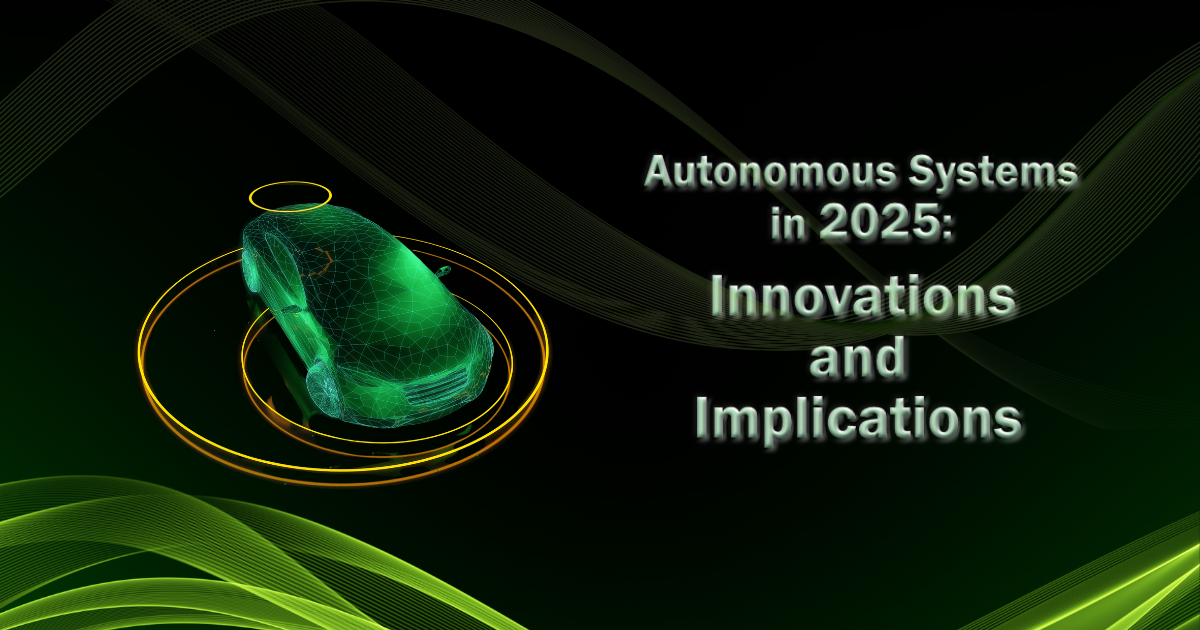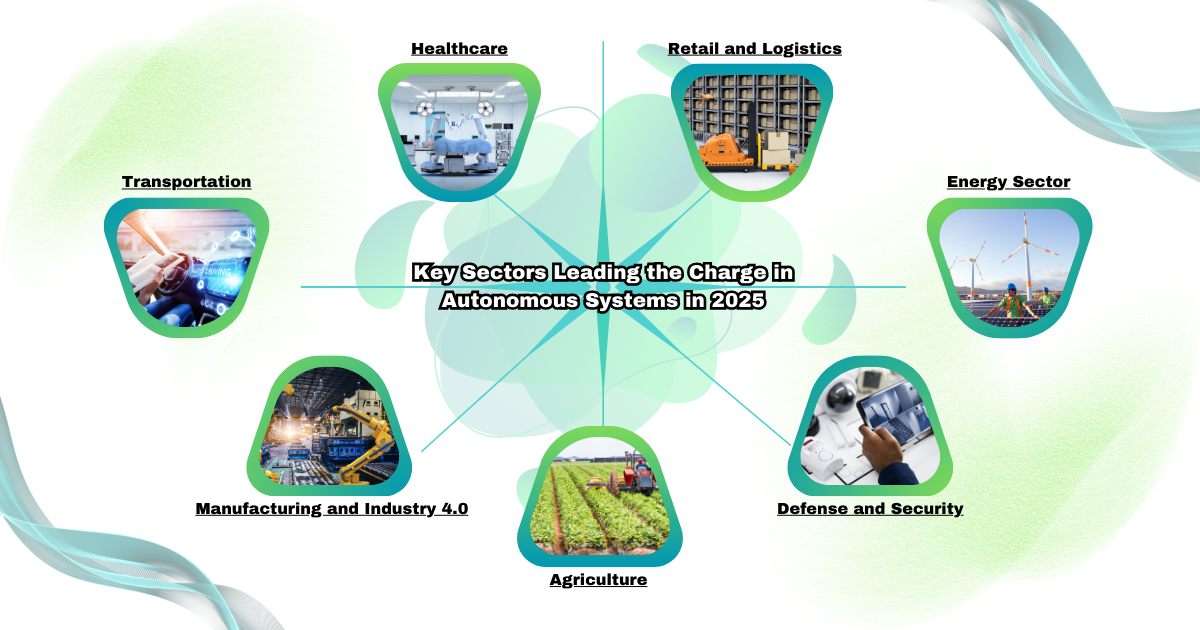Overview of Autonomous Systems in 2025
In 2025, autonomous systems have evolved into highly sophisticated, interconnected entities that are integral to many aspects of daily life and industry. Leveraging advanced artificial intelligence (AI), machine learning, sensor technology, and data networks, these systems can perform complex operations with minimal human intervention. The integration of these technologies has enabled real-time decision-making, predictive analysis, and adaptive learning capabilities.
Autonomous systems are now more capable of functioning independently in dynamic environments, thanks to significant advancements in deep learning algorithms, sensor accuracy, and seamless communication networks such as 5G. Their applications span a range of industries, from transportation and manufacturing to healthcare, agriculture, retail, logistics, and defense. The combination of AI-driven automation and IoT connectivity has led to substantial improvements in productivity, safety, and efficiency.
The current state of autonomous systems reflects a balance between rapid innovation and the challenges associated with technology adoption, regulation, and public trust. While they continue to reshape industries and improve operational efficiency, there remain key hurdles such as regulatory constraints, ethical considerations, and the need for robust cybersecurity measures.
Evolution of Autonomous Systems
Autonomous systems have evolved from rudimentary automation in manufacturing lines to sophisticated algorithms capable of managing entire ecosystems. This growth has been propelled by advancements in artificial intelligence (AI), machine learning, sensor technology, and robust data networks. The integration of these technologies has led to the development of systems capable of real-time decision-making, predictive analysis, and adaptive learning.
By 2025, the majority of autonomous systems feature a blend of AI capabilities that allow them to self-improve and operate efficiently in dynamic environments. For example, autonomous vehicles now leverage deep learning algorithms to navigate complex urban landscapes, adapting to unpredictable situations such as traffic congestion, adverse weather, and sudden pedestrian movements.
The evolution of autonomous systems in 2025 is marked by the following key developments:
• Enhanced AI Algorithms: Autonomous systems now incorporate more sophisticated AI algorithms that enable greater adaptability and context-aware decision-making.
• Seamless Integration with IoT: The synergy between autonomous systems and the Internet of Things (IoT) has created a networked ecosystem where machines share data in real-time, improving performance and efficiency.
• Improved Human-Machine Collaboration: Autonomous systems have become more collaborative, working alongside humans in a variety of roles, from manufacturing to customer service. This has reshaped job functions and required a reevaluation of human skills to complement automation.
• Advanced Perception Capabilities: With the integration of high-resolution sensors, cameras, and LIDAR technology, autonomous systems can better perceive and understand their environments, enabling safer and more precise operations.
These developments have collectively pushed autonomous systems into new realms of functionality and reliability, making them pivotal in various industries.
Key Sectors Leading the Charge
a. Transportation
The transportation sector has witnessed significant strides in autonomy, with self-driving cars and trucks becoming increasingly common. Companies like Tesla, Waymo, and new market entrants have refined their self-driving technology to achieve higher levels of autonomy, approaching full Level 5 automation. By 2025, autonomous public transportation services, such as shuttles and buses, are operational in smart cities worldwide, offering safe and efficient travel options.
b. Manufacturing and Industry 4.0
Autonomous systems in manufacturing have revolutionized Industry 4.0, where interconnected machines and intelligent systems coordinate production processes without human oversight. Robotics equipped with AI-driven vision and precision handling capabilities have improved the efficiency and safety of production lines. Predictive maintenance powered by IoT sensors ensures minimal downtime by diagnosing potential issues before they result in failures.
c. Healthcare
In healthcare, autonomous systems have contributed to significant improvements in patient care, diagnostics, and surgery. Robotic surgical assistants now operate with higher precision, reducing recovery times and improving outcomes. AI-driven diagnostic tools provide real-time analysis of medical images, leading to faster and more accurate detection of diseases. Furthermore, autonomous delivery drones supply medical equipment and medication to remote or underserved areas, enhancing healthcare accessibility.
d. Agriculture
Agriculture has also embraced autonomous technology, with self-driving tractors, drones, and AI-powered monitoring systems that assess crop health and optimize irrigation. These innovations have reduced the labor required for farming and increased yield predictability, making the industry more sustainable and resilient to climate change challenges.
e. Retail and Logistics
The retail and logistics sectors have experienced transformative changes due to autonomous systems. Automated warehouses now feature fleets of robots that manage inventory, process orders, and facilitate faster delivery times. Autonomous delivery vehicles and drones have optimized last-mile delivery processes, ensuring they are more efficient and cost-effective. In retail, self-checkout systems and AI-driven customer service bots provide personalized shopping experiences and streamline operations.
f. Defense and Security
The defense industry has adopted autonomous systems to enhance surveillance, reconnaissance, and tactical operations. Autonomous drones and robotic vehicles equipped with AI-driven analysis tools can patrol borders, monitor high-risk areas, and assist in search and rescue missions. These systems reduce human exposure to dangerous situations and improve the overall safety and effectiveness of military and security operations.
g. Energy Sector
The energy sector, including oil, gas, and renewable energy, has implemented autonomous technology to optimize operations. Drones and automated systems are used for pipeline inspections, offshore rig monitoring, and maintenance of wind turbines and solar panels. AI-powered data analytics enables predictive maintenance, improving operational efficiency and reducing costs.
Technological Advancements Fueling Growth
♦ AI and Machine Learning
In 2025, AI serves as the primary driving force behind autonomous systems. Sophisticated machine learning models enable these systems to recognize patterns, make decisions, and learn from outcomes. AI algorithms now process vast amounts of data from connected sensors, cameras, and external databases to ensure high accuracy and reliability.
♦ Sensor Technology
Advanced sensor technologies, including LIDAR, radar, and ultrasonic sensors, play a crucial role in the functioning of autonomous systems. By 2025, these sensors have become more compact, cost-effective, and capable of delivering higher resolution data, allowing autonomous systems to better perceive their environments.
♦ 5G and Edge Computing
The deployment of 5G networks and edge computing has provided the infrastructure needed for real-time data processing and low-latency communication. This has enabled autonomous systems to make instantaneous decisions, a necessity for applications like autonomous driving and industrial automation.
♦ Blockchain for Security
Blockchain technology ensures the security and traceability of autonomous systems, especially in sectors where data integrity is critical. Distributed ledger systems provide an immutable record of the decisions and processes performed by autonomous systems, which is essential for accountability and compliance.
Implications for Society
a. Economic Shifts
The widespread adoption of autonomous systems has both positive and negative economic implications. While these systems enhance productivity and reduce operational costs, they also pose challenges related to job displacement. The shift from manual labor to oversight and management roles requires a workforce with new skill sets, emphasizing the importance of reskilling and upskilling programs.
b. Urban Infrastructure
As autonomous systems become more prevalent, urban infrastructure must evolve to support them. Smart cities now incorporate features such as intelligent traffic management, dedicated lanes for autonomous vehicles, and automated waste management systems. These adaptations aim to create more efficient and sustainable living environments.
c. Ethical and Legal Considerations
The deployment of autonomous systems raises ethical questions about decision-making in high-stakes scenarios. For example, in an unavoidable accident involving an autonomous vehicle, how should the system determine which outcomes to prioritize? Moreover, regulatory frameworks need to adapt rapidly to ensure safety standards and liability laws keep pace with technological advancements.
Challenges and Barriers of Autonomous Systems in 2025
Autonomous systems have become pivotal in reshaping industries ranging from transportation to healthcare. While the potential is immense, the journey to widespread adoption faces numerous challenges and barriers. Understanding these obstacles is crucial for effective deployment and integration.
1. Technological Complexity
Autonomous systems rely on advanced technologies like AI, machine learning, and sensor networks. Ensuring seamless integration with existing infrastructures remains a major hurdle. For example, autonomous vehicles must communicate effectively with urban traffic systems, a task complicated by varying levels of technological maturity across regions. Additionally, real-time decision-making demands robust computational capabilities, often challenging the limits of current hardware. Addressing edge cases—unpredictable, rare scenarios—is another critical barrier, as these situations expose vulnerabilities in system programming and data handling.
2. Regulatory and Ethical Dilemmas
The absence of standardized regulations for autonomous systems presents a major obstacle to their adoption. Governments are struggling to keep pace with the rapid development of these technologies, leaving industries in a legal gray area. Determining accountability in the event of failures or accidents is another unresolved issue. For instance, if an autonomous vehicle causes an accident, should the blame fall on the manufacturer, the developer, or the system operator? Ethical concerns also arise, especially in systems required to make life-and-death decisions, such as in healthcare or autonomous warfare. These issues complicate public acceptance and deployment at scale.
3. Safety and Reliability
Securing the safety and reliability of autonomous systems is a top priority. Failures, whether due to software bugs, hardware malfunctions, or cyberattacks, can have devastating consequences. For instance, a cyberattack on an autonomous drone or vehicle could result in devastating consequences. Moreover, human-AI collaboration remains a challenge; striking the right balance between autonomy and human oversight is essential to prevent errors while maintaining efficiency.
4. Economic and Social Impact
The economic implications of autonomous systems are a double-edged sword. While automation promises cost savings and efficiency, it also threatens to displace millions of jobs, particularly in industries like logistics, manufacturing, and transportation. This transition creates a pressing need for workforce retraining and education to address skill gaps. Furthermore, the high cost of developing and deploying autonomous systems limits accessibility for smaller businesses and developing economies. Public skepticism and resistance to adopting these systems also present barriers, as trust in their capabilities and reliability is still growing.
5. Environmental Concerns
Despite their efficiency, autonomous systems have a significant environmental impact. Training machine learning models and running autonomous systems demand substantial energy, contributing to carbon emissions. Moreover, rapid technological advancements may render systems obsolete, creating a surge in electronic waste.
Future Prospects
The future of autonomous systems in 2025 looks promising, with continued innovation expected to address existing challenges and expand capabilities. Breakthroughs in AI, edge computing, and sensor technology will likely enhance the adaptability and efficiency of these systems. Emerging applications, such as autonomous aerial taxis and self-sustaining agricultural systems, will push the boundaries of what is possible.
a. Collaborative Robots (Cobots)
A promising development in the realm of autonomous systems is the rise of collaborative robots, or cobots. By 2025, cobots are common in industries where humans and machines share tasks. These robots are designed to work safely alongside human counterparts, enhancing productivity without the risk of fully replacing human labor.
b. Autonomous Supply Chains
End-to-end automation in supply chains is now a reality. Autonomous systems manage inventory, sort and package products, and coordinate deliveries using predictive algorithms. This has led to faster turnaround times and a more agile response to market demands.
c. Integration with Emerging Technologies
Autonomous systems are increasingly being integrated with other emerging technologies such as augmented reality (AR) and quantum computing. AR assists operators in visualizing complex data interactions, while quantum computing provides processing power for solving optimization problems in real-time, enhancing the capabilities of autonomous systems.
d. Focus on Sustainability
Autonomous technology is expected to contribute to sustainability goals, particularly in areas such as transportation and energy. The adoption of electric and autonomous vehicles, coupled with AI-driven optimization of resource consumption, will help reduce emissions and promote eco-friendly practices.
e. Enhanced Safety and Reliability
Safety improvements will remain a top priority for autonomous system developers. Continuous advancements in AI algorithms, coupled with rigorous testing and validation protocols, will help ensure that autonomous systems can operate more reliably in diverse environments.
f. Global Partnerships and Standards
International collaboration will be essential to establish common standards and best practices for autonomous technology. This will help create a more unified approach to regulation, development, and deployment, facilitating the global expansion of autonomous systems
Conclusion
The year 2025 marks a significant milestone in the evolution of autonomous systems. From transportation to healthcare, these technologies are redefining how industries operate, bringing about increased efficiency, safety, and innovation. However, along with these advancements come challenges related to ethics, security, and public perception. Addressing these issues will be crucial to fully harnessing the potential of autonomous systems and ensuring they contribute positively to society.
The future of autonomy holds immense promise, and continued interdisciplinary collaboration will be vital for navigating this transformative era. The journey from mere automation to true autonomy is ongoing, and 2025 stands as a testament to human ingenuity in the pursuit of a more automated world.





